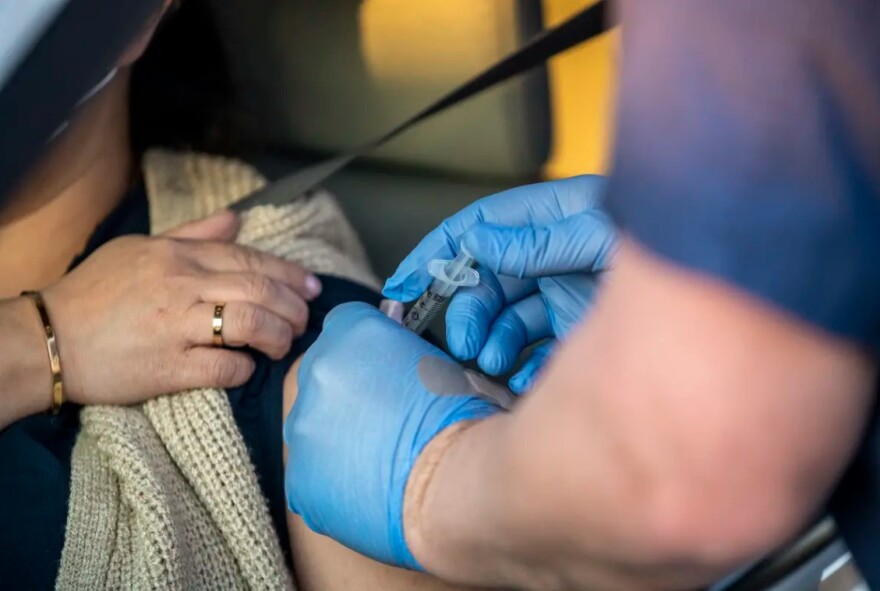Epidemiologist Katelyn Jetelina, author of , said more at-home antigen testing helps people track their exposure to the virus. But when people test at home, it's challenging to get an accurate case counts.
“Unfortunately, we didn’t put systems in place to accurately capture [the data],” Jetelina said. “The gaps between true cases and reported cases have gradually started widening and widening. So, it doesn’t look like it’s that bad of a wave right now in Texas, but we estimate this is actually the second-largest wave in the pandemic that we’ve experienced.”
While the number of infections is high, hospitalizations are still low, which Jetelina said means vaccines and booster shots are helping prevent more serious outcomes.
Chief Medical Officer for Sharon Davis said she’s not surprised by the increase.
“People are tired of getting vaccinated, and they’re not getting their boosters, and so the things that we know that are going to help stop spread unfortunately people are not doing anymore,” she said.
With summer events in full swing and reporting “masking behavior is at the lowest levels observed since the start of the pandemic,” there might be more chances to come in contact with someone who has COVID-19.
“Everybody in the medical community, I feel like we’re all just waiting and holding our breath a little bit,” Davis said.

So, when should I test for COVID-19?
Omicron is the most prevalent strain of COVID-19 in the United States, (CDC), which also lists multiple Omicron variants from BA.1 to BA.5. Since home testing is widely available (), Davis said it’s better to test if any symptoms appear.
Right now, COVID-19 symptoms can manifest as allergies: mild sore throat, itchy or runny nose, and sneezing. Dallas is one of the worst cities nationally for seasonal allergies, . But if there’s a question, Davis recommends testing twice within 48 hours to ensure it’s not COVID-19.
“Antigen tests are a lot better at telling us what we care about, which is if we’re infectious or not,” Jetelina added. “So, if you get a positive antigen test right now, trust it.”
What if I have a positive COVID-19 test?
People who are immunocompromised or have health complications may be eligible for , like Paxlovid, that reduce the chance of hospitalizations and death. The series of oral treatments are prescribed by a doctor and must be taken within five days of when symptoms start.
People can also visit , which can test for COVID-19 then provide medication and support on-site with a positive test.
But bottom line, it’s time to stay home and isolate.
“The time spent at home depends on a lot of things, but mainly whether you’re boosted or not,” Jetelina said. “It can range from five to 14 days, but on average is between eight and nine days.”
The CDC recommends that after a negative test and no symptoms, people can leave isolation at day five for groceries or other tasks if wearing a well-fitting mask. Davis said even with a negative test around five days, she doesn’t recommend people travel until 10 days after the first positive test.

COVID-19 recovery and immunity
When recovering at home, it’s important to monitor fluid levels. Davis said it’s common to have nausea, vomiting or diarrhea, so having popsicles or other drinks with electrolytes on hand is helpful.
“Go back to the basics,” Jetelina said. “Rest. Take Tylenol if you have a fever. Manage and keep track of your symptoms. For example, if your breathing is getting worse, keep track of that with at-home oxygen monitoring. Give your body a chance to fight the virus.”
People living with others in their home should stay in one specific area, use a separate bathroom, and wear a mask to ensure the virus is contained as much as possible.
, which can include persistent feelings of fatigue, headache, insomnia, anxiety and trouble concentrating even after a negative test. A studied patients with COVID-19 to identify who develops these symptoms, and why they develop in the first place, but didn’t find anything conclusive.
“What I’m hearing from a lot of folks is even after they’re over COVID, so to speak, the fatigue lasts,” Davis said. “So try to take care of yourself, because that’s normal.”
In addition, while previous research showed people who recover from the virus have immunity anywhere from , Jetelina said the Omicron strain has so many variants now the length of immunity isn’t clear.
“Omicron is mutating to escape our immunity even if we just got infected,” she said. “It feels like just yesterday, but the peak of the Omicron tsunami is now about six months ago. That immunity is waning pretty quickly. Since that January Omicron wave, Omicron has already changed substantially.”
Davis said she recommends still wearing masks in crowded public places and when traveling.
COVID-19 case increases heading into summer
Jetelina and Davis are both watching to see if cases and hospitalizations rise as more people travel over the summer and into the fall.
Davis said the number of people with booster shots or second booster shots is low, even though they are a helpful tool in lessening the virus’s severity. According to the CDC, almost in the United States have not received one.
“Without a doubt, it definitely keeps people from dying, and it looks like it definitely keeps down the severity of the disease,” Davis said. “Let’s stick with the things we know, even though we’re tired.”
Got a tip? Email Elena Rivera at erivera@kera.org. You can follow Elena on Twitter .
�Ļ�ӰԺ is made possible through the generosity of our members. If you find this reporting valuable, consider Thank you.



